
Deposition Date
2017-02-17
Release Date
2017-06-21
Last Version Date
2024-10-16
Entry Detail
PDB ID:
5UUM
Keywords:
Title:
Human Mcl-1 in complex with a Bfl-1-specific selected peptide
Biological Source:
Source Organism:
Homo sapiens (Taxon ID: 9606)
synthetic construct (Taxon ID: 32630)
synthetic construct (Taxon ID: 32630)
Host Organism:
Method Details:
Experimental Method:
Resolution:
2.35 Å
R-Value Free:
0.25
R-Value Work:
0.21
R-Value Observed:
0.21
Space Group:
C 1 2 1


